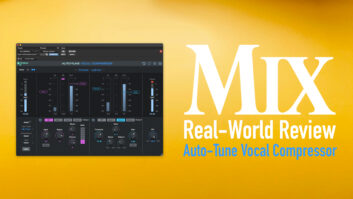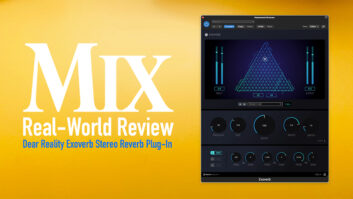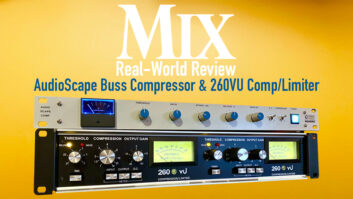
The front panel offers one set of controls for both channels; the rear panel sports left/right I/O and sidechain input.
In terms of pricing, the current market for outboard compressors is rather polarized. There are plenty of single- and dual-channel units priced above $1,200 and below $400, but few models priced in-between these points. Addressing this void is Chameleon Labs’ 7720 stereo compressor, designed to provide a clean audio path by using a minimal number of electronic components and employing VCAs manufactured by THAT Corp.
The 7720 is housed in a single-rackspace chassis. Given its price, the 7720’s construction is better than you’d expect. The front panel is almost ¼-inch thick and all of the knobs and switches have a very solid feel. Under the hood, the 7720 features a circuit board that’s well laid out, with socketed 5534, TLO72 and THAT 2180LA ICs, and 1-percent metal film resistors for low noise.
Out Front and Back
Front panel controls include meter select, highpass filter, threshold, attack, release, ratio and output gain. Its single VU meter can be switched to show left-or right-channel input level, left- or right-channel output level, or amount of gain reduction. The highpass filter has 60/90/130/200/440Hz settings and is applied to the compression detection circuit rather than the audio path. Its purpose is to reduce the detection circuit’s sensitivity to low frequencies so that pumping can be avoided when processing signals with a large amount of LF content. Also on the front panel are controls for power, compression in/out and sidechain-engage switches with respective LED indicators.
The rear panel has balanced XLR I/Os for each channel, plus a single XLR sidechain input that keys both channels. Also present are two power supply inputs: One is used with the included “line lump” transformer; the other accepts Chameleon Labs’ CPS-1 dual-rackmount power supply ($110), which can power two 7720s or a 7720 and Chameleon’s 7602 mic pre/EQ. For my tests I used the supplied line lump AC/DC adapter, which — other than posing the same minor annoyance as any similar style power supply — worked fine.
Flavorful Crunching
The 7720 is a stereo compressor in the true sense of the term. If you inject discrete signals into the left and right channels, a strong signal in one channel can trigger compression in the other channel. With one set of controls governing both channels, there’s no dual-mono mode, although one side of the 7720 can be used on a mono signal.
I used the 7720 in a variety of live and studio situations. First up was lead vocal. The 7720 easily tamed the dynamics of difficult lead vocalists without making its presence known under most circumstances. With careful attention to settings, I achieved 10 dB of transparent gain reduction by choosing one of the slower attack settings (e.g., 3 ms) and one of the gentler ratios (1.5:1 or 2:1). When processing any source, selecting the 7720’s fastest attack setting can make compression audible, but if the threshold is set just right, you can slam a lead vocal without making it sound compressed. It is also possible to crush the life out of any signal by setting the threshold very low and the ratio high — in which case, subtlety goes out the window.
Next up was a low-frequency synth bass that formed the foundation of a pop/dance tune, and contained a bit of an upper-midrange attack component that at times distracted from the lead vocal. Using a 4:1 ratio and attack, and 0.3ms release settings, the 7720 reined the sound into the mix, making the synth track louder so that it could rhythmically drive the mix without getting in the way of the other instruments. I didn’t notice that the synth was being compressed nor could I hear any tonal coloration from the 7720. The highpass filter was a critical part of the 7720’s success in this application. Without it, the low notes pulled down the synth’s high-frequency component. Setting the filter to 200 or 440 Hz solved this problem.
On a crunchy-sounding guitar, the 7720 was smooth and subtle, bringing out the sustain of an arpeggiated part. I set the unit to a 2:1 ratio, attack at 0.1 ms, release on “auto” and threshold almost all the way down. Even with gain reduction in the vicinity of 10 to 20 dB, I could not hear any side effects. Raising the ratio to 10:1 resulted in the guitar “popping” on the attack, but at no time did the guitar become dull — as is often the case using other compressors. In one instance, I triggered the sidechain from a lead vocal to duck the guitars. Whenever the lead vocal entered, the 7720 compressed the guitars a bit, dropping their level and making room for the lead vocal.
Goin’ Stereo
On stereo drum overheads, the 7720 is capable of providing two distinct flavors. First I set the ratio at 10:1, attack at 0.1 ms and the release at 0.3 ms. With the threshold cranked down and the highpass at 400 Hz, the 7720 kept the level of the kit consistent and smooth without crushing the cymbals whenever the kick drum hit. But if you’re looking to achieve a heavy pumping effect, simply bring the highpass filter down to about 60 Hz (or off) and the kick hits will trigger compression.
The highpass filter proved invaluable when using the 7720 on the stereo bus. In one instance, just a few dB of compression caused a lead vocal to dip too low in the mix on heavy kick drum and bass hits. Setting the highpass filter to 200 Hz returned consistency to the vocal and made the compression unnoticeable. In such cases, the HPF almost behaves like a crossover control, letting you fine-tune the amount of pumping caused by the signal’s LF content.
Used across my mixes where the chorus was thick with instrumentation, the 7720 did not get muddy or distorted. When set to provide 6 to 10 dB of gain reduction, the 7720 can provide that “radio-ready” vibe: With the attack at its fastest and the highpass filter disengaged, you can easily create FM/Top 40 radio-type of limiting (which I don’t care for). And as much I hate to use the word, adding the 7720 to the stereo bus results in increased “punch.”
Versatile, Affordable Unit
Chameleon Labs’ 7720 is well-made and easy to use, and it fills a niche in a price range that does not otherwise have a lot to offer. The 7720 has the ability to create both transparent and effect-type compression. It sounds great and is absolutely worth a listen.
In addition to being Mix‘s sound reinforcement editor, Steve La Cerra is the front-of-house engineer for Blue Öyster Cult.








